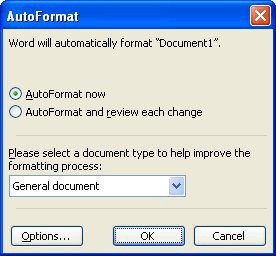Please Note: This article is written for users of the following Microsoft Word versions: 97, 2000, 2002, and 2003. If you are using a later version (Word 2007 or later), this tip may not work for you. For a version of this tip written specifically for later versions of Word, click here: AutoFormatting a Document.
Written by Allen Wyatt (last updated November 11, 2023)
This tip applies to Word 97, 2000, 2002, and 2003
Word includes a feature that formats what you type, as you type it. You probably take many of these automatic formatting (AutoFormat) adjustments for granted. Word does things like changing your quotes to Smart Quotes, automatically creating bulleted and numbered lists, and changing the indentation of paragraphs.
This is fine and good for many people, but what if you get a document from someone else and it needs a lot of the "little touches" applied to it? This is where the real industrial-strength AutoFormat feature of Word comes into play. You see, AutoFormat doesn't just work as you type—it also is available, on demand, to format an entire document. Here's how to AutoFormat your document:

Figure 1. The AutoFormat dialog box.
At this point, AutoFormat works its magic and your document is "reformatted" to appear as it would have if you had typed it yourself.
You should understand that it is very unlikely that AutoFormat will do all the formatting you need done. Each document is different, and you should make sure you examine the document after AutoFormat is completed to see if there are any other formatting tasks you need to complete.
WordTips is your source for cost-effective Microsoft Word training. (Microsoft Word is the most popular word processing software in the world.) This tip (638) applies to Microsoft Word 97, 2000, 2002, and 2003. You can find a version of this tip for the ribbon interface of Word (Word 2007 and later) here: AutoFormatting a Document.

Create Custom Apps with VBA! Discover how to extend the capabilities of Office 365 applications with VBA programming. Written in clear terms and understandable language, the book includes systematic tutorials and contains both intermediate and advanced content for experienced VB developers. Designed to be comprehensive, the book addresses not just one Office application, but the entire Office suite. Check out Mastering VBA for Microsoft Office 365 today!
You can easily use strikethrough formatting to show deleted text in a document. What if you want to actually overprint ...
Discover MoreIf you have a word that you need to make sure is formatted the same way throughout your document, there are several ways ...
Discover MoreUsers of WordPerfect know what parallel columns are. There is no such capability in Word, but there are ways you can ...
Discover MoreFREE SERVICE: Get tips like this every week in WordTips, a free productivity newsletter. Enter your address and click "Subscribe."
There are currently no comments for this tip. (Be the first to leave your comment—just use the simple form above!)
Got a version of Word that uses the menu interface (Word 97, Word 2000, Word 2002, or Word 2003)? This site is for you! If you use a later version of Word, visit our WordTips site focusing on the ribbon interface.
Visit the WordTips channel on YouTube
FREE SERVICE: Get tips like this every week in WordTips, a free productivity newsletter. Enter your address and click "Subscribe."
Copyright © 2026 Sharon Parq Associates, Inc.
Comments